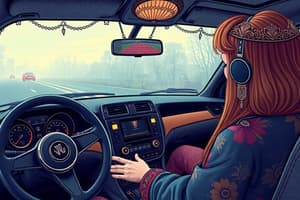Podcast
Questions and Answers
What is the key phrase to remember for Rule 1?
What is the key phrase to remember for Rule 1?
- Leave Yourself an Out
- Get the Big Picture
- Make Sure They See You
- Aim High in Steering (correct)
What does Rule 2 emphasize?
What does Rule 2 emphasize?
Get the Big Picture
Rule 3 advises to keep your eyes fixed in one direction.
Rule 3 advises to keep your eyes fixed in one direction.
False (B)
What is the main focus of Rule 4?
What is the main focus of Rule 4?
Which of the following is part of Rule 5?
Which of the following is part of Rule 5?
What is the purpose of the 10 Point Commentary?
What is the purpose of the 10 Point Commentary?
When starting up at an intersection, check ____ and ____.
When starting up at an intersection, check ____ and ____.
When stopped in traffic, a car length of space is required from the vehicle _____.
When stopped in traffic, a car length of space is required from the vehicle _____.
What should you do after the vehicle ahead has started to move?
What should you do after the vehicle ahead has started to move?
What is the recommended following time for speeds under 30 MPH?
What is the recommended following time for speeds under 30 MPH?
How often should you check your mirrors while driving?
How often should you check your mirrors while driving?
What should you look for when scanning steering wheels?
What should you look for when scanning steering wheels?
It is not important to have eye contact with drivers along your path.
It is not important to have eye contact with drivers along your path.
What should you do when you are approaching a stale green light?
What should you do when you are approaching a stale green light?
When pulling from the curb, check your mirrors, signal, and glance over your ____ shoulder.
When pulling from the curb, check your mirrors, signal, and glance over your ____ shoulder.
Flashcards are hidden until you start studying
Study Notes
UPS 5 Seeing Habits
- Aim High in Steering: Focus on an imaginary target to maintain proper lane positioning and ensure a safe path well ahead.
- Get the Big Picture: Assess the overall scene beyond immediate obstacles to enhance awareness, avoid distractions like billboards, and ensure smooth stops and turns.
- Keep Your Eyes Moving: Regularly shift your gaze; check the front every 2 seconds and rear every 5-8 seconds to enhance situational awareness and avoid fixation at intersections.
- Leave Yourself an Out: Always maintain an escape route. Ensure sufficient space around your vehicle, particularly in front, and stay prepared for unexpected situations.
- Make Sure They See You: Actively communicate with other road users using horns, lights, and signals; establish eye contact to minimize risks.
10 Point Commentary
- Starting Up at Intersection: Look left, right, and left again before proceeding; also check rear view mirrors for additional awareness.
- When Stopped in Traffic: Maintain a distance of a car length from the vehicle ahead to afford escape and cushion space.
- Count 1, 2, 3 After Vehicle Aheads Moves: Observe the vehicle in front for a moment post-movement; this aids in maintaining a safe distance.
- 4-6 Seconds Following Time: Keep a following distance of 4-6 seconds under 30 MPH and 6-8 seconds over 30 MPH to avoid fixation and allow reaction time.
- 8-12 Seconds Eye-Lead Time: Focus your vision 8-12 seconds ahead to ensure awareness of your path and surrounding environment.
- Scan Steering Wheels: Check for any occupied cars at the curb; this indicates potential movement from parked cars, posing a potential threat.
- Stale Green Lights: Establish a decision point before reaching stale green lights to ensure safety in case of a sudden change.
- Eye Contact: Seek eye contact with pedestrians or other drivers to confirm safety before proceeding; use signals to communicate when necessary.
- Pulling from Curb: Always check mirrors and signal, and glance over your left shoulder for safe merging into traffic.
- Use of Mirrors: Regularly check mirrors every 5-8 seconds to maintain spatial awareness and monitor surrounding traffic.
Studying That Suits You
Use AI to generate personalized quizzes and flashcards to suit your learning preferences.




